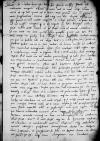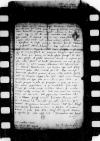Magnum chaos est inter nos et vos, itaque minime mirum est, quod litterae, quas ad te scribo aut pereunt, aut non perferuntur, aut supprimuntur. Memini ego, utique me tibi aliquot epistulas misisse, prout et nunc mitto atque ita, ut reliquum fasciculum a ⌊patre⌋ tuo ad me missum vicissimque a te (utpote ex tam diverso orbe) satis crebro a te litterae cum ad ⌊regem⌋, tum ad ceteros mittuntur, ad me vero ne iota quidem praeter ⌊⌋, quas ego 1525-05-21⌊XXI die Maii1525-05-21⌋ accepi, in quibus etiam massa auri Hispanici inclusa erat, pro quo et habui tibi iam aliis litteris (si modo perlatae sunt) gratias et praesentibus habeo. Utut est, sive scribis, et litterae mihi non redduntur, sive maioribus occupatus cessas, sive negligis, nihil refert, ego te nihilominus amo, te suspicio, de te (crede mihi) dies noctesque cogito. Illud tamen me non modice perturbavit, quod hodie primum intellexi tua consuetudine et familiaritate diutius mihi superinscribed⌈mihimihi superinscribed⌉ carendum esse, audio enim, te perpetuum oratorem istuc apud ⌊caesarem⌋ designatum esse atque de sumptibus necessariis tibi honorifice provisum. Si meorum dumtaxat commodorum rationem habere<m>, mallem tecum hic vle vel unam frugi cenulam, sed cum tuae laudi et dignitati faveo, eo aequiori animo fero tui desiderium, quod sciam tibi eam condicionem, quae tibi vel invito obtigit, tibi et tuis decori et perpetuo ornamento futuram, modo vita suppetat.
Nescio, quo fato vel infortunio sit, ut quotiescumque a ⌊rege⌋ litterae ad te mittuntur, non prius mihi constat, quam ea ipsa hora, cum iam tabellarius dimittitur atque ita multa scribendi tempus mihi non conceditur, ut vel modo contigit, quod, si mihi paucis ante horis scire licuisset, litteras videlicet ad te mitti, nescio, si tibi gratificatus fuissem, certe Iliadae nostrarum rerum te explevissem, nunc, quia urgeor ab his, qui litteras mittendas curaturi sunt, cogor omnia relinquere, tuo forsitan commodo. Verendum enim erat, ne tibi forsitan importune superinscribed⌈forsitan importuneforsitan importune superinscribed⌉ obstrependo te occiderem. Illud scias serenissimum dominum nostrum ⌊regem⌋ atque ita et dynastas nostros ad retinendam et vindicandam veterem religionem eamque stabiliendam animum adiecisse, prohibetur severissimis edictis, ne ⌊Lutheri⌋ libri legantur et profanis de fide ne hiscere liceat in alterutram partem, hoc est neque eam vituperare nec laudare,  BCz, 243, p. 32 idque eo accuratius fit, quod ⌊Slesia⌋ tota iam pridem, ⌊Prussia⌋ vero et praesertim ⌊Gdanum⌋ tuum doctrinam Evangelii, ut ipsi dicunt, ut nos errorem et sacrilegium, immo Cymerias tenebras, profitetur et sequitur.
BCz, 243, p. 32 idque eo accuratius fit, quod ⌊Slesia⌋ tota iam pridem, ⌊Prussia⌋ vero et praesertim ⌊Gdanum⌋ tuum doctrinam Evangelii, ut ipsi dicunt, ut nos errorem et sacrilegium, immo Cymerias tenebras, profitetur et sequitur.
Venerunt nuper huc decenti comitatu ⌊Gdanenses⌋ tui. Princeps legationis eorum idemque proconsul magister ⌊Georgius Cymmerman⌋ quidam, item Könnigk ex ms. et(!)
⌈exex ms. et(!)
⌉ fabro ferrario senator factus, conati sunt rerum a se gestarum rationem regi reddere eiusque rei ore eiusdem magistri Georgii praefationem publice amplissimis verbis, sermone Germanico, Scripturas intermiscentes, praefationem fecerunt. Sed postea res in conclave reiecta est atque ita, libellis dumtaxat, cum eis agitur, a me ista omnia celantur. Nescio, quid rei est, admirabilis tela texitur, quam ego coniectura dumtaxat perspicio. Minitatur acriter ⌊Gdanensibus⌋, nisi resipiscant. Quid futurum sit, Deus novit.
⌊Dux Prussiae⌋ per ⌊Slesiam⌋ volitat. ⌊Collegium Varmiense⌋ magna contentione ⌊Brausperk⌋ et ⌊Tolkmit⌋ a ⌊rege⌋ repetit, nam quamvis dominus ⌊dux Prussiae⌋ secundum pactum eisdem oppidis cesserit, tenentur tamen pro rege, eo quod ea episcopus ipse per incuriam suam perdiderat. Et de ⌊Prussia⌋ ad praesens tantum.
A ⌊Turcis⌋ et ⌊Tartaris⌋ nulla nobis nunc sollicitudo est. ⌊Turcus⌋ templum Iani hanc aestatem totam occlusit, misit enim ⌊Ibreym Bassam⌋ (cuius opera et auctoritate, quamvis adulescentuli) praecipue utitur ad Orientis provincias, ut videlicet ⌊Egyptum⌋ ⌊Syriam⌋que in novam ordinationem dirigeret, et priusquam idem Bassa redierit nemini bellum illaturus. Ita mihi nuntius ⌊eius⌋, qui apud ⌊regem⌋ ad contrahendam amicitiam missus erat, mihi retulit.
⌊Tartari⌋ inter se dissident. ⌊Quorum⌋ dissensione nihil nobis optabilius. Nepos ex fratre pepulit patruum regno, rursus patruus vires colligit. Nepos ipse, Aslam Soltan nomine, is videlicet, qui superiori anno incursioni in nos factae praefuit, misit huc ad nos his diebus oratores suos, asserens se victorem. Sed cum ego uni eorum obiecissem, cum victor existat, cur Chersonesum (quam ipsi fossam vocant) declinat, et per solitudines cum iumentis et mulieribus vagatur, ipse illico obmutuit, et revera ita se res
 BCz, 243, p. 33
habet. Stativa in in ulteriori ripa ⌊Borystenis⌋ e regione Towane or Towauc⌈TowaneTowane or Towauc⌉ fixit, ille vero, qui victus dicitur, quemque triennio ante ⌊imperator Turcorum⌋ in paternum regnum miserat, in sua sede manet atque ita in illa rerum varietate nos quiescimus.
BCz, 243, p. 33
habet. Stativa in in ulteriori ripa ⌊Borystenis⌋ e regione Towane or Towauc⌈TowaneTowane or Towauc⌉ fixit, ille vero, qui victus dicitur, quemque triennio ante ⌊imperator Turcorum⌋ in paternum regnum miserat, in sua sede manet atque ita in illa rerum varietate nos quiescimus.
Et tantum de externis non enim iam vacat scribere, nam urgeor. Illud tamen vel volanti calamo adscribam. Nuper dominus ⌊Iheroslaus de Lasko⌋ palatinus Syradiensis, fuit hic ⌊Cracoviae⌋ et praefecturam Mariemburgensem a ⌊rege⌋ obtinuit, tandem regem venatum in ⌊Niepolomice⌋ cum ⌊regina⌋ profi<ci>scente et ipse secutus est. Ibi (ut fieri solet) in nocturno symposio apud ⌊Severinum Boner⌋, qui ⌊patruo⌋ in omnibus officiis successit, cum domino Andrea Posnaniensi ad quandam contentionem devenit et crescente iurgio alter alterum ad duellum provocavit. Res acta est hic ⌊Cracoviae⌋ in iudicio magna contentione, sed definitio eius in ⌊conventum⌋ Pyotrkouiensem, qui forsitan qui circiter Calendas Decembres haberi debet, reiecta est etc.
Ego tametsi decumanis fluctibus quatiar (de quo multa scribenda essent), tamen ut Marpesia rupes (Deo gratia) adhuc immotus maneo exercentibus me his, quos fortuna, cum ei iocari libuit, ex humili provexit et forte ex gurgustio, a quibus ego tamen me amari existimabam, at ipsi invidebant, quamvis nihil in me est, unde mihi invidere debeant, sed mala mens, malus animus etc. Litteras, quas factori tuo miseras, curavi ad ⌊Columbam⌋ tuam perferendas. Corrodentur libri tui a blattis, priusquam redibis.
Principes Moraviae sunt hic: dominus Ioannes de Bernsteyn, qui hodie apud regem publice peroravit, Demostenem tonantem diceres. Dominus item Dobyessz Czernohorski, ea superinscribed⌈eaea superinscribed⌉ proceritate et forma, ut ⌊Achilem⌋ vel ⌊Hectorem⌋ diceres.
Vale, vale, vale. Numquam tecum loquendo satiarer, sed cessandum est. Vale, iterum vale.
 BCz, 243, p. 32 idque eo accuratius fit, quod
BCz, 243, p. 32 idque eo accuratius fit, quod  BCz, 243, p. 33
habet. Stativa in in ulteriori ripa
BCz, 243, p. 33
habet. Stativa in in ulteriori ripa  BCz, 243, p. 32
Soles me relegare ad l(itte)ras hidden by binding⌈[as]as hidden by binding⌉
BCz, 243, p. 32
Soles me relegare ad l(itte)ras hidden by binding⌈[as]as hidden by binding⌉  BCz, 243, p. 33 regias vel domini episcopi Cracoviensis
BCz, 243, p. 33 regias vel domini episcopi Cracoviensis  BCz, 243, p. 32 sed falleris.
cf. Hor. Epist. 1.1.4 ⌊Non eadem est aetas hidden by binding⌈[s]s hidden by binding⌉
BCz, 243, p. 32 sed falleris.
cf. Hor. Epist. 1.1.4 ⌊Non eadem est aetas hidden by binding⌈[s]s hidden by binding⌉  BCz, 243, p. 33 n hidden by binding⌈[n]n hidden by binding⌉o(n) menscf. Hor. Epist. 1.1.4 ⌋
. Reicimus fixis etc., nosti cetera.
BCz, 243, p. 33 n hidden by binding⌈[n]n hidden by binding⌉o(n) menscf. Hor. Epist. 1.1.4 ⌋
. Reicimus fixis etc., nosti cetera.



